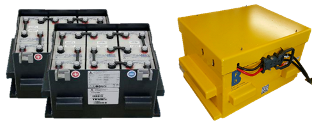
|
Quick-Info-Page SBB Battery Redesign - Technisches |

|
In Kooperation mit SBB |





|
Further Innovation: · Internal 800 W soft charge converter 20 A · Heating 60 W each cell (+10K in 24 min) · Fully operation (charging and discharging) -20°C to 45°C · Space reduction of 50 % · Controlled chargng operation as flexible as the different board net systems · Overal less expensive than current solution: Reduced energy consumption and lower life cycle costs due to Wearout-dependent service life thanks to diagnostic system |
|
Die Bordnetz-Batterie im |

|
Features |
Battery Status quo |
Eval. model BFH |
|
Energy at 3h-discharge |
6.1 kWh @ +20°C 2.9 kWh @ -20°C |
6.5 kWh @ +20°C 3.5 kWh @ -20°C |
|
Nominal Pack Voltage |
36 V (2 x 9 cells) |
35.2 V (11 cells) |
|
Technology / Chemistry |
Lead-acid (VRLA) |
LiFeYPO4 (LFYP) |
|
System weight |
334 kg (in 2 troughs) |
110 kg (-67%) |
|
Energy density at cell level (3h-discharge) |
23 Wh/kg @ +20°C 14 Wh/kg @ -20°C |
105 Wh/kg @ +20°C 71 Wh/kg @ -20°C |
|
Lifetime at given profile |
5-8 Years |
12 – 20 Years |
|
acquisition costs |
CHF 2'500.- |
CHF 4'500.- |
|
Diagnostics, Monitoring, Features |
-Charging is controlled by external charger without taking care of battery's health -Charger meassures temperature in battery-room only |
Internal intelligence: -Monitoring of voltage and temperature even on cell level -current monitoring -Semiconductor-Main switch |